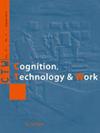Muscle strength in Brazilian firefighters with non-specific chronic low back pain: A cross-sectional study.
IF 3.4
3区 工程技术
Q2 ENGINEERING, INDUSTRIAL
引用次数: 0
Abstract
BACKGROUND Imbalance between flexor and extensor muscles of the trunk could negatively influence spinal stability. OBJECTIVES Investigate the strength balance between flexor and extensor muscles of the trunk in military firefighters with non-specific chronic low back pain (NSCLBP). METHODS One hundred and two male firefighters were assessed in an isokinetic dynamometer at 120°/s and 60°/s to investigate the balance ratio between flexor and extensor (F/E) muscles. RESULTS An F/E ratio of 0.72 (SD: 0.22; 95% CI: 0.67-0.76; SEM: 0.02) was observed at 60°/s and 0.94 (SD: 0.41; 95% CI: 0.85-1.03; SEM: 0.04) at 120°/s. The mean peak torque of the extensor muscles was 343.1 N.m/Kg (SD: 94.87; 95% CI: 322.8-363.5; SEM: 10.23) at 60°/s and 270.5 N.m/Kg (SD: 113; 95% CI 246.3-294.8; SEM: 12.18) at 120°/s. The mean peak torque of the flexor muscles was 232.4 N.m/Kg (SD: 53.86; 95% CI 220.8-243.9; SEM: 5.81) at 60°/s and 223.8 N.m/Kg (SD: 66.34; 95% CI 209.6-238.1; SEM: 7.15) at 120°/s. All torques generated by the extensor muscles were higher than the flexor muscles (p < 0.05). CONCLUSIONS Firefighters with NSCLBP presented a normal F/E balance ratio and higher strength of extensor muscles of the trunk.巴西消防员非特异性慢性腰痛的肌肉力量:一项横断面研究。
背景:躯干屈肌和伸肌之间的平衡会对脊柱稳定性产生负面影响。目的探讨军人非特异性慢性腰痛(NSCLBP)患者躯干屈肌和伸肌的力量平衡情况。方法在120°/s和60°/s的等速测功机中对102名男性消防员进行了屈伸肌平衡比(F/E)的评估。结果F/E比值为0.72 (SD: 0.22;95% ci: 0.67-0.76;扫描电镜(SEM): 0.02)在60°/s和0.94 (SD: 0.41;95% ci: 0.85-1.03;扫描电镜:0.04)在120°/s。伸肌平均峰值扭矩为343.1 N。m/Kg (SD: 94.87;95% ci: 322.8-363.5;扫描电镜:10.23)在60°/s和270.5 N。m/Kg (SD: 113;95% ci 246.3-294.8;扫描电镜:12.18)在120°/s。屈肌平均峰值扭矩为232.4 N。m/Kg (SD: 53.86;95% ci 220.8-243.9;扫描电镜:5.81)在60°/s和223.8 N。m/Kg (SD: 66.34;95% ci 209.6-238.1;扫描电镜:7.15)在120°/s。伸肌产生的扭矩均高于屈肌(p < 0.05)。结论消防员NSCLBP的F/E平衡比正常,躯干伸肌强度较高。
本文章由计算机程序翻译,如有差异,请以英文原文为准。
求助全文
约1分钟内获得全文
求助全文
来源期刊

Cognition Technology & Work
ENGINEERING, INDUSTRIAL-
CiteScore
6.90
自引率
7.70%
发文量
26
审稿时长
>12 weeks
期刊介绍:
Cognition, Technology & Work focuses on the practical issues of human interaction with technology within the context of work and, in particular, how human cognition affects, and is affected by, work and working conditions.
The aim is to publish research that normally resides on the borderline between people, technology, and organisations. Including how people use information technology, how experience and expertise develop through work, and how incidents and accidents are due to the interaction between individual, technical and organisational factors.
The target is thus the study of people at work from a cognitive systems engineering and socio-technical systems perspective.
The most relevant working contexts of interest to CTW are those where the impact of modern technologies on people at work is particularly important for the users involved as well as for the effects on the environment and plants. Modern society has come to depend on the safe and efficient functioning of a multitude of technological systems as diverse as industrial production, transportation, communication, supply of energy, information and materials, health and finance.
 求助内容:
求助内容: 应助结果提醒方式:
应助结果提醒方式:


